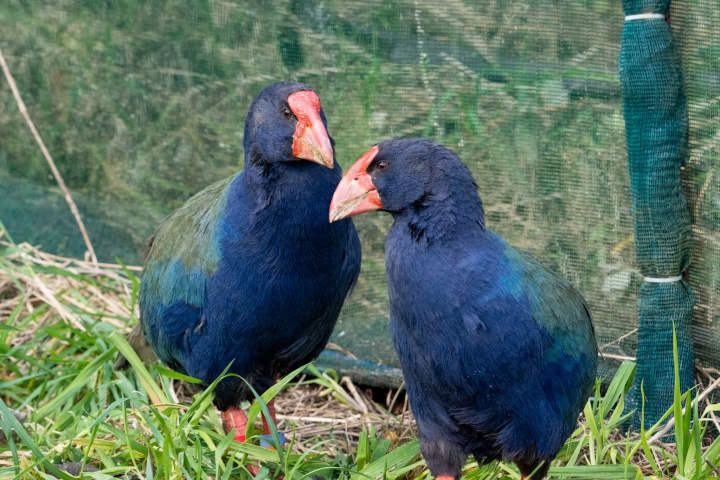Wellington’s Population Of Threatened Native Bird (takahē) Doubles
The Wellington city population of a rare native bird has doubled this week, with Wellington ecosanctuary Zealandia Te Māra a Tāne welcoming a new pair of takahē on 28 August 2023.

Bendigo and Waitaa. Credit: Scott Langdale
There are nearly 500 of these manu/birds left in the world. Their population is managed at a national level by the Department of Conservation’s Takahē Recovery Team working with Ngāi Tahu, and birds are moved around the country to support the health and growth of the population.
Jo Ledington, General Manager Conservation and Restoration at Zealandia says, “The story of takahē recovery shows that we can’t do conservation work in isolation. It takes partnership and collaboration to help this population to grow.”
The new takahē to Zealandia are Waitaa (female, 3 years old) and Bendigo (male, 6 years old) who came from the Burwood Takahē Centre near Te Anau. The birds were welcomed to Zealandia Te Māra a Tāne alongside Taranaki Whānui ki Te Upoko o Te Ika, Ngāti Toa Rangatira and Ngāi Tahu representatives.
“The Hem of Remutaka Jobs for Nature project team led by Kirihi Nohotima represented Taranaki Whānui and Ngāti Toa Rangatira to officially receive the takahē. A loving, efficient and gentle welcome to their new home was conducted with a small gathering that included sanctuary whānau who whakapapa Kai Tahu, Kati Mamoe and Waitaha which was very special,” says Terese McLeod (Taranaki Whānui, Clan McLeod), Zealandia’s Lead Ranger of Bicultural Engagement.
By hosting this pair, Zealandia Te Māra a Tāne are assisting with takahē recovery efforts through advocacy. The young pair are believed to be infertile and while they will nest, they are not expected to produce chicks. There is limited breeding habitat in Aotearoa for these manu due to predators and loss of tussock grassland habitat. Hosting this pair at Zealandia ensures valuable breeding habitat is available for another pair that can have chicks. Zealandia Te Māra a Tāne is also accessible for New Zealanders and international visitors to meet these precious taonga, who were once thought to be extinct.
“Zealandia Te Māra a Tāne has nearly 140,000 visitors annually and is an incredibly valuable advocacy site for this nationally vulnerable species, which are naturally found in mountainous and inaccessible habitat. The fact that you can travel 10 minutes from the centre of our capital city and see these rare manu is amazing,” says Ledington.
There will be plenty of opportunity for visitors to see Waitaa and Bendigo once they are settled into the sanctuary. It is also likely that walkers and bikers on the outside of the fence will see the takahē pair along the fence line as they settle in.
Waitaa and Bendigo are the second pair of takahē who currently call Zealandia home. Nio (18) and Orbell (22) live in Zealandia’s wetlands area.
Notes to editors:
- Takahē were thought to be extinct for over 50 years, before they were rediscovered in 1948 by Geoffrey Orbell in the Murchison Mountains in Fiordland. Sadly, the North Island takahē is extinct, and all remaining takahē are South Island takahē.
- Takahē have special cultural, spiritual and traditional significance to Ngāi Tahu. Ngāi Tahu value takahē as a taonga (treasure) and they continue to act as kaitiaki (guardians) of the takahē by working with DOC to protect this precious species.
- The South Island takahē is the largest living rail in the world. Often confused with pūkeko, they are a much larger bird, with thick legs and a large, bright red bill that extends on to the forehead.
- Zealandia’s existing pair are called Nio (F, 18) and Orbell (M, 22). They are elderly birds who are monitored closely and already reside in the wetland area of the sanctuary which only has enough space for one pair. Bendigo and Waitaa will live further up in the sanctuary.


 Tennis NZ: New Zealand Billie Jean King Cup Team Qualify For World Group Play-Offs
Tennis NZ: New Zealand Billie Jean King Cup Team Qualify For World Group Play-Offs University of Auckland: Online Gaming Review On Pacific Youth - Urgent Need For More Research
University of Auckland: Online Gaming Review On Pacific Youth - Urgent Need For More Research UCOL: UCOL Ākonga Awarded $28,000 In Freemasons Willson Lewis Scholarship
UCOL: UCOL Ākonga Awarded $28,000 In Freemasons Willson Lewis Scholarship Auckland Museum: Auckland Museum Announces Inaugural Matafatafa Aho Pacific Artist In Residence
Auckland Museum: Auckland Museum Announces Inaugural Matafatafa Aho Pacific Artist In Residence PHARMAC: Pharmac To Fund Medicines For Blood Cancers, Inflammatory Bowel Disease, Eczema And Arthritis
PHARMAC: Pharmac To Fund Medicines For Blood Cancers, Inflammatory Bowel Disease, Eczema And Arthritis  NZ Principals Federation: Principals Support NZEI's Call For Learning Support Boost
NZ Principals Federation: Principals Support NZEI's Call For Learning Support Boost